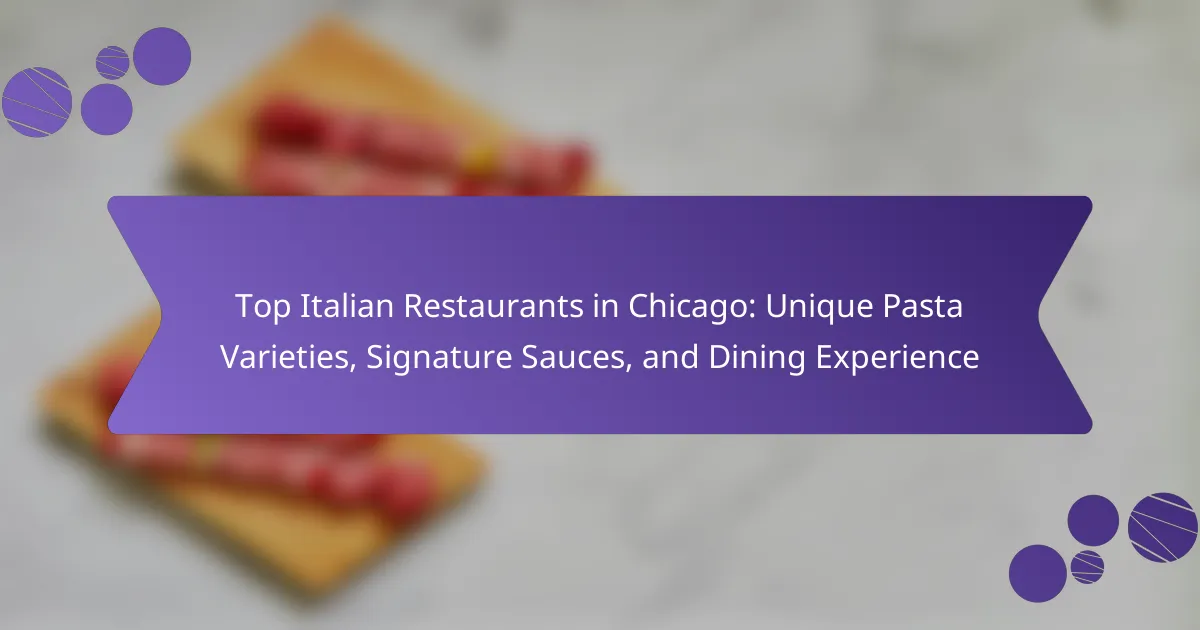
What are the top Italian restaurants in Chicago?
The top Italian restaurants in Chicago include Spiaggia, Alinea, and Osteria Langhe. Spiaggia is renowned for its upscale dining and authentic Italian cuisine. Alinea offers a unique dining experience with innovative dishes. Osteria Langhe specializes in Northern Italian fare, particularly from the Piedmont region. Other notable mentions are Giordano’s, famous for deep-dish pizza, and Eataly, which features a variety of Italian eateries. These restaurants consistently receive high ratings for their food quality and service.
How do these restaurants stand out in the culinary scene?
These restaurants stand out in the culinary scene through their innovative pasta varieties and signature sauces. They offer unique dishes that reflect regional Italian flavors. Many utilize fresh, locally sourced ingredients to enhance authenticity. Their commitment to traditional cooking techniques sets them apart from competitors. Additionally, they provide immersive dining experiences that engage all the senses. High-quality service complements the exceptional food, creating memorable visits. Recognition from culinary awards further validates their excellence. Collectively, these factors contribute to their distinct presence in Chicago’s vibrant dining landscape.
What unique attributes define these Italian restaurants?
Unique attributes that define these Italian restaurants include authentic regional dishes and artisanal pasta-making techniques. Many establishments emphasize traditional recipes passed down through generations. Signature sauces often feature homemade ingredients, enhancing flavor profiles. A focus on high-quality, locally sourced ingredients is common among these restaurants. Some offer unique dining experiences, such as open kitchens or chef’s tables. Seasonal menus reflect the availability of fresh produce. Additionally, many Italian restaurants provide a curated wine selection to complement their dishes. These attributes contribute to a distinctive culinary experience that sets them apart.
How do customer reviews reflect their dining experiences?
Customer reviews reflect dining experiences by providing insights into food quality, service, and atmosphere. Reviews often detail specific dishes, highlighting flavors and presentation. Customers frequently mention the attentiveness of staff and overall service speed. Positive reviews typically emphasize enjoyable experiences, while negative reviews point out dissatisfaction. For instance, a review may praise a restaurant’s homemade pasta as exceptional. Additionally, reviews often comment on the ambiance, influencing potential diners’ perceptions. According to a study by BrightLocal, 79% of consumers trust online reviews as much as personal recommendations. This trust underscores the impact of customer feedback on dining choices.
What types of pasta do these restaurants offer?
The restaurants offer a variety of pasta types. Common options include spaghetti, fettuccine, and penne. Some locations feature unique varieties like pappardelle and orecchiette. Additionally, many restaurants serve stuffed pasta such as ravioli and tortellini. Gluten-free and whole wheat options are also available at select establishments. Seasonal pasta dishes may incorporate fresh ingredients. These offerings reflect traditional Italian cuisine. Each restaurant may have its own signature pasta dishes to highlight their culinary style.
Which unique pasta varieties are featured on their menus?
It is not possible to provide a specific answer to the question regarding unique pasta varieties featured on their menus. This information requires access to the menus of various Italian restaurants in Chicago, which can vary frequently. Without specific restaurant names or menu details, a concrete answer cannot be provided.
How are these pasta dishes prepared and served?
Pasta dishes are typically prepared by boiling the pasta until al dente. The cooking time varies depending on the type of pasta used. After boiling, the pasta is drained and may be tossed with olive oil to prevent sticking.
Sauces are prepared separately, often by sautéing garlic and onions in olive oil. Fresh ingredients, such as tomatoes or cream, are then added to create the sauce. The cooked pasta is combined with the sauce and mixed thoroughly to coat evenly.
Pasta dishes are served hot, often garnished with fresh herbs or grated cheese. Presentation may vary, with some dishes served in bowls and others plated artistically. Seasonal vegetables or proteins, like chicken or seafood, may be added for additional flavor and nutrition.
What signature sauces enhance the pasta dishes?
Signature sauces that enhance pasta dishes include marinara, Alfredo, and pesto. Marinara sauce is a classic tomato-based sauce rich in flavor. It typically includes garlic, onions, and herbs. Alfredo sauce is a creamy blend of butter, cream, and Parmesan cheese. This sauce adds richness to fettuccine and other pasta types. Pesto sauce, made from basil, garlic, pine nuts, and olive oil, offers a fresh and aromatic flavor. Each sauce complements different pasta varieties, elevating the overall dining experience.
What are the most popular sauces among diners?
The most popular sauces among diners include marinara, Alfredo, and pesto. Marinara sauce is a classic tomato-based sauce, widely favored for its rich flavor. Alfredo sauce, made with cream and Parmesan cheese, is beloved for its creamy texture. Pesto, a blend of basil, garlic, and nuts, offers a fresh and vibrant taste. According to industry surveys, marinara consistently ranks as a top choice in Italian cuisine. Alfredo sauce is frequently requested in pasta dishes, highlighting its popularity. Pesto’s unique flavor profile appeals to diners seeking something different. These sauces are staples in many Italian restaurants, reflecting their widespread appeal.
How do these sauces complement the pasta varieties?
Sauces enhance pasta varieties by adding flavor, texture, and aroma. For example, a rich marinara sauce pairs well with spaghetti, complementing its long strands. Creamy Alfredo sauce coats fettuccine, enriching its wide surface area. Pesto, made from fresh basil, elevates the taste of penne with its herbaceous notes. A light olive oil and garlic sauce enhances the delicate flavors of angel hair pasta. Each sauce is crafted to balance the pasta’s shape and texture, creating a harmonious dish. The right sauce can also highlight specific ingredients in the pasta, such as vegetables or proteins. This careful pairing is essential in Italian cuisine, where sauce and pasta work together to create a memorable dining experience.
What is the overall dining experience like at these restaurants?
The overall dining experience at top Italian restaurants in Chicago is characterized by a blend of authentic cuisine and warm hospitality. Guests enjoy a vibrant atmosphere that reflects Italian culture. Many restaurants feature open kitchens, allowing diners to witness the preparation of dishes. The menus highlight unique pasta varieties and signature sauces, enhancing the culinary experience. Service is typically attentive and knowledgeable about the menu offerings. Many establishments also offer wine pairings to complement meals. Overall, the experience is designed to be memorable, inviting guests to savor each moment.
What ambiance and decor contribute to the dining atmosphere?
Ambiance and decor significantly influence the dining atmosphere. Elements such as lighting, color schemes, and furniture style create a specific mood. For instance, dim lighting often fosters intimacy, while bright colors can energize the space. The use of natural materials, like wood and stone, enhances a warm and inviting feel. Additionally, artwork and decorative items can reflect cultural themes, enhancing the dining experience. Research indicates that a well-designed environment can improve customer satisfaction and encourage longer visits. A study published in the Journal of Hospitality & Tourism Research found that ambiance directly impacts diners’ perceptions of food quality and service.
How does service quality impact customer satisfaction?
Service quality significantly influences customer satisfaction. High service quality leads to positive customer experiences. Customers feel valued when they receive prompt and attentive service. This enhances their overall dining experience. In the context of restaurants, quality service includes staff knowledge and friendliness. According to a study published in the Journal of Hospitality Management, 70% of diners prioritize service quality. Satisfied customers are more likely to return and recommend the restaurant. This creates a loyal customer base, crucial for restaurant success.
How do these restaurants cater to different dietary preferences?
Top Italian restaurants in Chicago cater to different dietary preferences by offering a diverse menu. They provide vegetarian, vegan, and gluten-free options. Many restaurants use fresh ingredients to create flavorful dishes that meet dietary needs. For example, they may offer gluten-free pasta alternatives. Additionally, some establishments highlight plant-based sauces and toppings. Nutritional information is often available to assist diners. This approach ensures inclusivity for various dietary restrictions. Many restaurants also accommodate specific requests for modifications.
What gluten-free pasta options are available?
Gluten-free pasta options include those made from rice, corn, quinoa, and lentils. Rice pasta is widely available and has a neutral flavor. Corn pasta offers a slightly sweet taste and firm texture. Quinoa pasta is high in protein and has a nutty flavor. Lentil pasta is rich in fiber and has a hearty consistency. These alternatives cater to gluten-sensitive individuals while providing diverse culinary experiences. Many Italian restaurants now feature these gluten-free options on their menus to accommodate dietary preferences.
How do they accommodate vegetarian and vegan diners?
Top Italian restaurants in Chicago accommodate vegetarian and vegan diners by offering diverse menu options. Many restaurants provide plant-based pasta alternatives made from ingredients like chickpeas or lentils. They often include a variety of vegetable-based sauces, such as marinara or pesto made without cheese. Some establishments also feature seasonal vegetable dishes that highlight local produce. Additionally, many restaurants are willing to modify existing dishes to meet dietary preferences. This flexibility ensures that vegetarian and vegan diners can enjoy a satisfying meal. Many Chicago restaurants are increasingly aware of dietary restrictions and actively promote their vegetarian and vegan offerings.
What tips can enhance the dining experience at Italian restaurants in Chicago?
To enhance the dining experience at Italian restaurants in Chicago, consider these tips. First, explore the regional specialties of Italian cuisine. Chicago’s Italian restaurants often feature dishes from different regions of Italy. Second, pair your meal with appropriate wines. Many restaurants offer sommelier recommendations that complement the flavors of the dishes. Third, share dishes to experience a variety of flavors. Family-style dining is common in Italian culture. Fourth, engage with the staff for recommendations. Knowledgeable servers can guide you to hidden gems on the menu. Fifth, be mindful of the restaurant’s ambiance. A cozy setting can elevate the overall experience. Lastly, consider visiting during off-peak hours for a more relaxed dining atmosphere. These tips can significantly enhance your experience while enjoying authentic Italian cuisine in Chicago.
The main entity of the article is the top Italian restaurants in Chicago, focusing on their unique pasta varieties, signature sauces, and overall dining experience. The article highlights notable establishments such as Spiaggia, Alinea, and Osteria Langhe, detailing their culinary excellence, innovative dishes, and commitment to authentic Italian cuisine. It explores the distinctive attributes that set these restaurants apart, including their use of fresh ingredients, artisanal pasta-making techniques, and exceptional service. Additionally, the article examines customer feedback, dietary accommodations, and tips to enhance the dining experience, providing a comprehensive overview of Chicago’s vibrant Italian dining scene.




